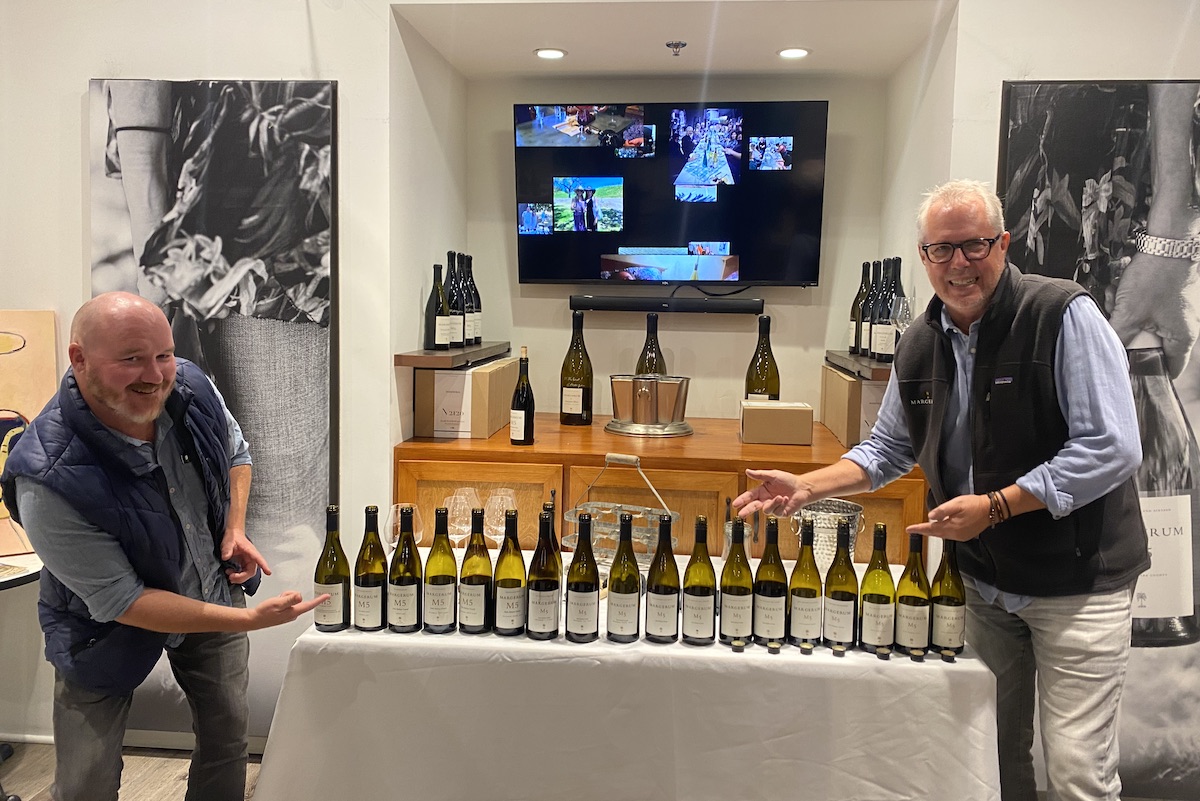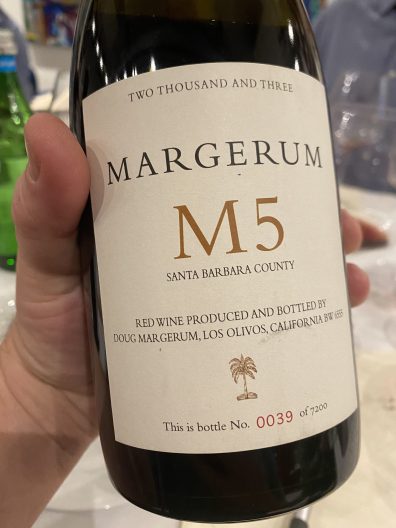Two Decades of Margerum Wine’s M5
Doug Margerum Shares 18 Vintages of His Signature Red Rhône Blend

Doug Margerum Shares 18 Vintages of His Signature Red Rhône Blend

The vertical tasting, in which multiple vintages of the same wine are tasted in chronological order, is the most enlightening enological experience that exists. Because the basic bones of each wine are similar, sipping through the lineup — whether it’s just from three subsequent years or across two decades — reveals the differences of each year’s weather, the nuances of vineyards as they age, and the evolution of a winemaker’s technique. Vintners who dare to present verticals lay bare their life’s work, opening a window into the triumphs and tribulations of their past for all in attendance to debate.
Doug Margerum dared as much last week, when he invited seven wine professionals to taste through 18 vintages of M5, his signature Santa Barbara County–grown red blend of five grapes: grenache, syrah, mourvèdre, counoise, and cinsault. Inspired by the wines of Châteauneuf-du-Pape in France’s Rhône Valley, M5 is the face of Margerum Wine Company, which he launched in 2001 following two decades of owning and operating the Wine Cask on Anacapa Street. After two vintages of crafting a syrah-grenache-mourvèdre blend, Margerum was able to track down the last two grapes in 2003, and M5 was born.

“We use grenache as the base, and then add syrah ’til it tips and mourvèdre ’til we like it,” explained Margerum, although syrah was the dominant percentage due to lack of available grenache until 2011. “The counoise and cinsault are the salt and pepper.”
Our tasting was organized in three flights of five, descending from the not-yet-released 2020 vintage, all the way down to 2006; the last three wines came out more casually after those first 15. In addition to me, in attendance were Margerum Wine Co. employees Stephen Janes, Tom DeWalt, and Lisa Delanty as well as bouchon owner Mitchell Sjerven (who also ran a later incarnation of Wine Cask with Margerum), San Ysidro Ranch sommelier Tristan Pitre, and Tony Cirincione, the regional sales rep for Chambers & Chambers Wines.
For me, all of the wines exhibited a very floral character, somewhere between rose and carnation, with a hint of cinnamon, whether they were from riper vintages, like 2015, or more austere ones, like 2011. We had minor disagreements, like when Sjerven thought the 2011 — whose peppery spice I loved — to be a tad astringent, to which Margerum suggested pairing cheese.
Sjerven also thought the 2012 may be hitting its peak, meaning that it would only devolve with time. “No!” replied Margerum, offering an argument otherwise related to color, flavor, and mouthfeel. Pitre piped up, “It’s probably the most developed of the wines.” That satisfied Margerum, who thanked Pitre with a laugh, offering, “Clearly, you’re the one who sells wines.”
Sign up to get Matt Kettmann’s Full Belly Files, which serves up multiple courses of food & drink coverage every Friday, going off-menu from our regularly published content to deliver tasty nuggets of restaurant, recipe, and refreshment wisdom to your inbox
Margerum discussed the changes over the years: the move from corks to screwcaps in 2014 (when he did half cork/half cap); the shift to estate-grown syrah in 2016; the creation of the M5 Reserve program in 2007; the launch of an M5 White in 2015. He also clarified that he hasn’t been the day-to-day winemaker since 2016, when Michael Miroballi took those reins.
“I still do the blends, but I’m not there every day. Look at my hands,” he said, showing off fingers and palms that weren’t stained purple like most winemakers sport this time of year. “They’re clean.”

What hasn’t changed is Margerum’s approach to fermentation, which he does in a very slow and cool manner, compared to the hot and fast approach that many employ, in part to free up tanks faster to fit more grapes. The gentle approach retains complexity in the finished wines and keeps them lively even as the years tick by.
The evidence in that regard was stark, for we found that the oldest wine in each flight — the 2016, the 2011, and the 2006 — to be the freshest of each series. And then came the 2003, perhaps the most vibrant of them all.
“It’s uncanny,” said Janes. “It’s the oldest wine on the table.” Sjerven concurred. “You’re right,” he said. “The ’03 is unbelievable.” After Janes did a quick search on his computer, he reported back, “There’s only 12 bottles left of the 2003 — actually, minus the one we just drank.”
That’s why you say yes when invited to verticals such as this one, because there’s only so much left of any vintage. “None of these wines are for sale,” said Margerum. “It’s just a trip down memory lane.”
That turned out to only be partially true. The entire Margerum Wine Co. library just went on sale through the website, including a handful of the M5s we tasted, plus wines they no longer make, like Klickitat pinot gris from Washington and Purisima Mountain bottlings.
Meanwhile, the 2021 harvest — which many are claiming to be one of the best ever due to its length, though we’ve heard that before — continued into its 48th day. “It will be the longest vintage on record for Margerum,” said Margerum, who still had 60 tons left hanging on the vines that November 8 night. I’ll be honored to taste how they contribute to the next M5, whether we get vertical again next year or, more likely, wait another decade.
See margerumwines.com.
Support the Santa Barbara Independent through a long-term or a single contribution.
Please note this login is to submit events or press releases. Use this page here to login for your Independent subscription
Not a member? Sign up here.
You must be logged in to post a comment.